Factsheet 2: Municipalities and renewable energy communities – a perfect match
Dutch English German Italian Latvian Norwegian Polish Portuguese Spanish
Best practice renewable energy communities (RECs) are on the rise throughout Europe. Even before the gradually improving enabling framework induced by the Clean Energy Package, energy communities had been sprouting up across most European countries. Now, with the transposition and implementation of the recast Renewable Energy Directive (RED II) as well as the Internal Electricity Market Directive (IEMD), new energy communities are developing at a pace never seen before. Based on an in-depth analysis of 21 good practices, the COME RES team has distilled the list into 10 best practice cases with considerable adaptation and transferability potential. The featured energy communities possess different socio-economic benefits, the most prominent of which are to ensure adequate participation and (financial) (co-)ownership, the promotion of a self-sufficient and environmentally conscious lifestyle, the creation of more social cohesion, as well as the lowering of energy bills and tackling energy poverty.
Every energy community analysed operates within its own particular regulatory context, which means that not only the business rationale, but even the overall ease of operations, can differ significantly. A common denominator and shared driving force can, however, be identified in nearly all cases: the presence of municipalities. Municipalities are key participants and enablers of the renewable energy communities in the good practice list and have an intrinsic interest in creating socio-economic benefits as part of their local energy and climate planning.
Keep reading to discover more about the COME RES best practices and the motivations and actions of the municipalities involved.
Publication Date: 05 Apr 2022
Author: Arthur Hinsch, Carsten Rothballer and Lucy Russell (ICLEI Europe)
